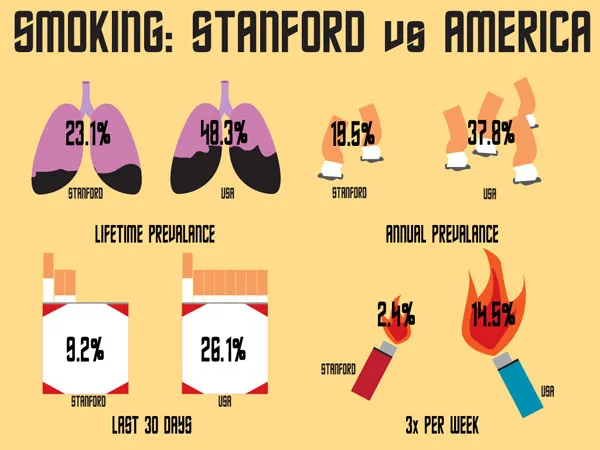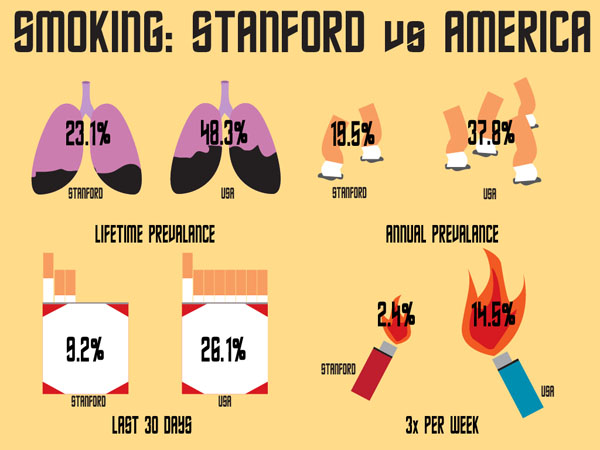
The survey indicated that Stanford was around 50 percent below national averages both in the number of students who had used tobacco in the last year and students who had ever used tobacco.
Chronic smoking, indicated by students who say they smoke three times or more per week, came in more than 83 percent below national averages at only 2.4 percent of survey respondents.
“I was pleasantly surprised by the results of the study,” said Ralph Castro, director of the Office of Alcohol Policy and Education (OAPE). OAPE administered the Core Survey to assess trends in alcohol use at Stanford. The survey, standardized nationally, also gathers data on use of tobacco and other drugs.
Providing a variety of data, the survey illustrated the perceptions of students toward tobacco as well as quantitative information about the frequency and locations of usage. Results of the study showed that 23.1 percent of students say they have used tobacco over the last year, compared with the national average of 48.3 percent.
The numbers provided by the survey may reflect on the culture of tobacco use at Stanford.
“I think it is, in part, a reflection of California and the tough restrictions on smoking in the Bay Area,” Castro said. “In many parts of California, there is no smoking in restaurants, bars and public spaces, based on city and country ordinances. From a policy standpoint, taxation on cigarettes that fund educational programs, educational services and public service announcements have made a real impact on smoking statistics in California.”
The survey population also demonstrated that gender differences might be a factor related to tobacco usage at Stanford. Over 80 percent of women said they never used tobacco, while only 68 percent of men reported similarly.
Many students said that the smoking culture at Stanford is highly social, although not prevalent.
“It’s more of a social thing when I see people smoking,” said Salish Harrison ‘13, a Peer Health Educator in Arroyo. “Group wise, more men do it than women. Usually when I see smokers, it is at night or at parties smoking outside, and it’s normally when people are drunk that they smoke.”
The Core Survey supported this perception — the highest category where people said they used tobacco was at private parties, followed closely by the second highest, in the home.
“A lot of times alcohol and cigarettes go together; there is a social smoking attitude among young adults,” Castro said. “People say they smoke when they drink.”
“As a former smoker, I wouldn’t say I often see students smoking throughout the day around campus, but at night there is a higher percentage of people smoking,” Harrison said. “In terms of consumption, the order of popularity that I notice usually goes cigarettes, hookah and then chewing tobacco. Hookah is definitely a more social activity.”
Castro said that different populations of students might have different influences leading them to smoke.
“A population in which I think smoking rates may be higher is the graduate student body,” Castro said. “My observation stems from the knowledge that there are higher smoking rates in international countries, and we have large percentage of international students from Europe, Asia and countries outside of the United States, and these students may be coming here with smoking habits.”
Reflecting the low rates of tobacco usage, there is limited access to cigarettes on the Stanford campus.
“There are not that many places on campus to buy cigarettes; the only place close to the center of campus is the Valero gas station on Campus Drive,” said Ikshu Neithalath ‘15.
The low tobacco consumption results indicated by the Core Survey also reflect a healthy culture among the Stanford population.
“I have noticed a stigma about tobacco at Stanford,” Harrison said. “Stanford is a very health-minded campus, and people are very health-conscientious.”
Stanford currently does not have a prominent anti-tobacco campaign, but Castro said that the survey, which will be administered every year from now on, will serve as a baseline against which to measure future trends.
“We collected the data and are currently doing cursory analysis,” Castro said. “From there, we will develop educational programs. The results of the February survey will be used as benchmark to move forward, but overall I am glad that students are making good choices as related to tobacco.”
